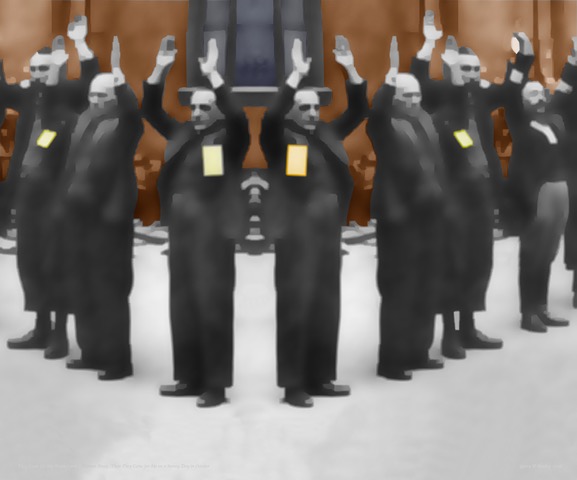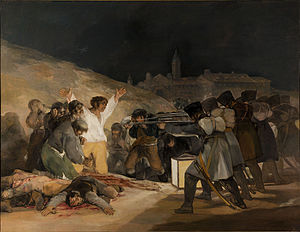You have /5 articles left.
Sign up for a free account or log in.

"Meeting Under a Black Moon on the Plains of Despair"
Garry D. Harley
Garry D. Harley is no fan of President-elect Donald J. Trump. Harley, an artist from Lowell, Mass., says the rhetoric of Trump's campaign reminded him again and again of efforts in history to demonize and subjugate black people in the United States and oppressed groups throughout history. So Harley was pleased to be asked by Salem State University to create works inspired by the election for an exhibit, "State of the Union." The works were selected before Election Day and the exhibit opened just after.
Harley pulled no punches in his pieces, both of which are digital works based in part on historical photographs. For one (above), he took (with permission) a photograph of the journalist Anthony S. Karen and portrayed a group of members of the Ku Klux Klan, to show the kind of hate Harley believes has been given respectability by the Trump campaign.
 For another (at right), he worked with photographs of the roundup of Jews after the Warsaw ghetto uprising in 1943 to show the kind of inhumanity that can be unleashed by bigotry and hatred.
For another (at right), he worked with photographs of the roundup of Jews after the Warsaw ghetto uprising in 1943 to show the kind of inhumanity that can be unleashed by bigotry and hatred.
To Harley (who gave permission for his artworks to be reproduced with this article), portraying hatred is not the same thing as promoting hatred. But that message was lost at Salem State. Many students objected to his art (and other pieces in the show). The university announced last week it was closing the exhibit, pending discussions about how to go forward.
Calls, Visits and Social Media
Almost as soon as the exhibit opened, students (in particular but not exclusively black students) started complaining to Salem State officials and posting objections on Twitter. The Klan image attracted most of the criticism, but not all of it.
Two representative comments on Twitter: "Why did Salem state think it was OK to put a pic of the KKK in the art gallery during election time?? [Shaking my head]," and (with a photo of the Klan artwork) "Salem State thinks this is an acceptable piece of art to hang up in their public art gallery …"
Salem State first responded by trying to draw more attention to the artists' intentions regarding their works. The university typically has a booklet in the middle of the gallery in which artists' statements are provided. Officials said they believed most people weren't reading the statements, so the university took the statements and posted them next to various works of art.
The university also covered the glass doors to the gallery so that people wouldn't happen to see an image without context. Further, the university posted a sign outside the gallery stating that the exhibit contained some work that could offend some viewers.
An Apology From the University
The university then arranged for an open forum last week to discuss the exhibit. After the forum, at which students criticized the exhibit and talked about the pain it caused them, Salem State announced that it would close the exhibit for now and would consider further steps to take this week.
"We would like to apologize to those in the campus community who have experienced distress resulting from this exhibit. We are sorry. Yesterday’s conversation made clear the strong emotions this exhibit has caused," said a statement issued by Mary Melilli, chair of art and design at Salem State, and Ken Reker, curator of the university's gallery.
"Art is often intended to spark discussion about societal ills. In this case, it did just that, but we deeply regret the distress it has caused students," the statement added. "We thank the students for sharing their views, and we look forward to working with them to determine how to move forward."
On Salem State's Facebook page, the university faced criticism from a variety of perspectives. One comment expressed support for the criticism of the Klan artwork. "You wouldn't have to close the art exhibit if you just removed the painting, very poor judgment," a comment said.
But others said that the university was engaged in inappropriate censorship. "I'm appalled that any institution of higher education would choose to remove the art," said one comment. "Art is supposed to generate strong reaction, and not everyone is going to like/approve of the art. A college is supposed to provide a safe place at which people can voice their opinions, regardless of how politically correct they are (hence, tenure). However, if you remove the painting, you also remove the opportunity for people to discuss the KKK and how it relates to the history of the U.S. and to the art exhibit as a whole. Does Salem State have any plans to remove courses which might discuss slavery or Jim Crow or any other subject which might cause their snowflake students to melt?"
Goya and Picasso
Harley, in an interview, said that he attended last week's forum, hoping for "a teaching moment."

 He brought and shared images of such paintings as "The Third of May 1808," by Francisco Goya (at left), and "Guernica," by Pablo Picasso (at right). Harley said he wasn't trying to compare his artistic talent to those legendary painters, but to show the students the long tradition of painting what one opposes, and what one is horrified by. Goya portrayed French soldiers killing members of a Spanish uprising against Napoleon's forces. Picasso depicted the way Spanish fascists -- along with their German and Italian allies -- destroyed a town.
He brought and shared images of such paintings as "The Third of May 1808," by Francisco Goya (at left), and "Guernica," by Pablo Picasso (at right). Harley said he wasn't trying to compare his artistic talent to those legendary painters, but to show the students the long tradition of painting what one opposes, and what one is horrified by. Goya portrayed French soldiers killing members of a Spanish uprising against Napoleon's forces. Picasso depicted the way Spanish fascists -- along with their German and Italian allies -- destroyed a town.
Harley explained that he viewed his art as warning about the dangers of Trump's rhetoric and that he viewed art as a tool with which to spread alarm. But he said that "the anger of the students sort of overwhelmed" what he was trying to say.
At one point, Harley said that, with mixed feelings, he offered to remove the Klan image if that would allow the exhibit to otherwise remain open, but he said that students rejected that idea, as there were other artworks that bothered them.
"I saw a lot of projected anger in the room, and it had nothing to do with a thoughtful understanding of the piece," he said.
Harley said that he thought Salem State was surprised by the students' anger. Part of displaying art at a campus, he said, is defending free expression "and they weren't prepared to do that."
'Very Strong Emotions'
Asked about how the decision to close the exhibit, even temporarily, could be consistent with support for academic and artistic freedom, Melilli said via email that "the decision to temporarily suspend the exhibition was reached by the curator and myself and resulted from the very strong emotions in the room when we gathered to discuss the artworks. Students, faculty and staff all expressed concerns about pieces in the exhibition and reactions to these artworks. We agreed that it made sense to take a breath and revisit the conversation after the Thanksgiving holiday."
She added that "academic freedom is central to this conversation" and that the curator (also a professor) "has the freedom" to reopen the exhibit if he wishes, and that she would support "whatever decision he ultimately makes."








